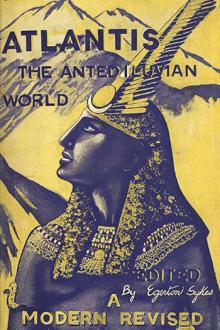Atlantis: The Antedeluvian World by Ignatius Donnelly (thriller novels to read .TXT) 📕

- Author: Ignatius Donnelly
- Performer: -
Book online «Atlantis: The Antedeluvian World by Ignatius Donnelly (thriller novels to read .TXT) 📕». Author Ignatius Donnelly
And even skepticism must pause before the miracle of the continued existence of this strange people, wading through the ages, bearing on their shoulders the burden of their great trust, and pressing forward under the force of a perpetual and irresistible impulse. The speech that may be heard to-day in the synagogues of Chicago and Melbourne resounded two thousand years ago in the streets of Rome; and, at a still earlier period, it could be heard in the palaces of Babylon and the shops of Thebes—in Tyre, in Sidon, in Gades, in Palmyra, in Nineveh. How many nations have perished, how many languages have ceased to exist, how many splendid civilizations have crumbled into ruin, bow many temples and towers and towns have gone down to dust since the sublime frenzy of monotheism first seized this extraordinary people! All their kindred nomadic tribes are gone; their land of promise is in the hands of strangers; but Judaism, with its offspring, Christianity, is taking possession of the habitable world; and the continuous life of one people—one poor, obscure, and wretched people—spans the tremendous gulf between “Ptah-hotep” and this nineteenth century.
If the Spirit of which the universe is but an expression—of whose frame the stars are the infinite molecules—can be supposed ever to interfere with the laws of matter and reach down into the doings of men, would it not be to save from the wreck and waste of time the most sublime fruit of the civilization of the drowned Atlantis—a belief in the one, only, just God, the father of all life, the imposer of all moral obligations?
CHAPTER VII.
THE ORIGIN OF OUR ALPHABET
One of the most marvellous inventions for the advancement of mankind is the phonetic alphabet, or a system of signs representing the sounds of human speech. Without it our present civilization could scarcely have been possible.
No solution of the origin of our European alphabet has. yet been obtained: we can trace it back from nation to nation, and form to form, until we reach the Egyptians, and the archaic forms of the Phœnicians, Hebrews, and Cushites, but. beyond this the light fails us.
The Egyptians spoke of their hieroglyphic system of writing not as their own invention, but as “the language of the gods.” (Lenormant and Cheval, “Anc. Hist. of the East,” vol. ii., p. 208.) “The gods” were, doubtless, their highly civilized ancestors—the people of Atlantis—who, as we shall hereafter see, became the gods of many of the Mediterranean races.
“According to the Phœnicians, the art of writing was invented by Taautus, or Taut, ‘whom the Egyptians call Thouth,’ and the Egyptians said it was invented by Thouth, or Thoth, otherwise called ‘the first Hermes,’ in which we clearly see that both the Phœnicians and Egyptians referred the invention to a period older than their own separate political existence, and to an older nation, from which both peoples received it.” (Baldwin’s “Prehistoric Nations,” p. 91.) The “first Hermes,” here referred to (afterward called Mercury by the Romans), was a son of Zeus and Maia, a daughter of Atlas. This is the same Maia whom the Abbé Brasseur de Bourbourg identifies with the Maya of Central America.
Sir William Drummond, in his “Origines,” said: “There seems to be no way of accounting either for the early use of letters among so many different nations, or for the resemblance which existed between some of the graphic systems employed by those nations, than by supposing hieroglyphical writing, if I may be allowed the term, to have been in use among the Tsabaists in the first ages after the Flood, when Tsabaisin (planet-worship) was the religion of almost every country that was yet inhabited.”
Sir Henry Rawlinson says:
“So great is the analogy between the first principles of the Science of writing, as it appears to have been pursued in Chaldea, and as we can actually trace its progress in Egypt, that we can hardly hesitate to assign the original invention to a period before the Hamitic race had broken up and divided.”
It is not to be believed that such an extraordinary system of sound-signs could have been the invention of any one man or even of any one age. Like all our other acquisitions, it must have been the slow growth and accretion of ages; it must have risen step by step from picture-writing through an intermediate condition like that of the Chinese, where each word or thing was represented by a separate sign.
The fact that so old and enlightened a people as the Chinese have never reached a phonetic alphabet, gives us some indication of the greatness of the people among whom it was invented, and the lapse of time before they attained to it.
Humboldt says:
“According to the views which, since Champollion’s great discovery, have been gradually adopted regarding the earlier condition of the development of alphabetical writing, the Phœnician as well as the Semitic characters are to be regarded as a phonetic alphabet that has originated from pictorial writing; as one in which the ideal signification of the symbols is wholly disregarded, and the characters are regarded as mere signs for sounds.” (“Cosmos,” vol. ii., p. 129.) Baldwin says (” Prehistoric Nations,” p. 93): “The nation that became mistress of the seas, established communication with every shore, and monopolized the commerce of the known world, must have substituted a phonetic alphabet for the hieroglyphics as it gradually grew to this eminence; while isolated Egypt, less affected by the practical wants and tendencies of commercial enterprise, retained the hieroglyphic system, and carried it to a marvellous height of perfection.”
It must be remembered that some of the letters of our alphabet are inventions of the later nations. In the oldest alphabets there was no c, the g taking its place. The Romans converted the g into c; and then, finding the necessity for a g Sign, made one by adding a tail-piece to the c (C, G). The Greeks added to the ancient alphabet the upsilon, shaped like our V or Y, the two forms being used at first indifferently: they added the X sign; they converted the t of the Phœnicians into th, or theta; z and s into signs for double consonants; they turned the Phœnician y (yod) into i (iota). The Greeks converted the Phœnician alphabet, which was partly consonantal, into one purely phonetic—“a perfect instrument for the expression of spoken language.” The w was also added to the Phœnician alphabet. The Romans added the y. At first i and j were both indicated by the same sound; a sign for j was afterward added. We have also, in common with other European languages, added a double U, that is, VV, or W, to represent the w sound.
The letters, then, which we owe to the Phœnicians, are A, B, C, D, E, H, I, K, L, M, N, O, P, Q, R, S, T, Z. If we are to trace out resemblances with the alphabet of any other country, it must be with these signs.
Is there any other country to which we can turn which possessed a phonetic alphabet in any respect kindred to this Phœnician alphabet? It cannot be the Chinese alphabet, which has more signs than words; it cannot be the cuneiform alphabet of Assyria, with its seven hundred arrow-shaped characters, none of which bear the slightest affinity to the Phœnician letters.
It is a surprising fact that we find in Central America a phonetic alphabet. This is in the alphabet of the Mayas, the ancient people of the peninsula of Yucatan, who claim that their civilization came to them across the sea in ships from the east, that is, from the direction of Atlantis. The Mayas succeeded to the Colhuas, whose era terminated one thousand years before the time of Christ; from them they received their alphabet. It has come to us through Bishop Landa, one of the early missionary bishops, who confesses to having burnt a great number of Maya books because they contained nothing but the works of the devil. He fortunately, however, preserved for posterity the alphabet of this people. We present it herewith.
### LANDA’S ALPHABET (From “North Amer. of Antiquity,” p. 434.) Diego de Landa was the first bishop of Yucatan. He wrote a history of the Mayas and their country, which was preserved in manuscript at Madrid in the library of the Royal Academy of History. . . . It contains a description and explanation of the phonetic alphabet of the Mayas.Landa’s manuscript seems to have lain neglected in the library, for little or nothing was heard of it until it was discovered by the French priest Brasseur de Bourbourg, who, by means of it, has deciphered some of the old American writings. he says, ‘the alphabet and signs explained by Landa have been to me a Rosetta stone.’” (Baldwin’s “Ancient America,” p. 191.)
When we observe, in the table of alphabets of different European nations which I give herewith, how greatly the forms of the Phœnician letters have been modified, it would surprise us to find any resemblance between the Maya alphabet of two or three centuries since and the ancient European forms. It must, however, be remembered that the Mayas are one of the most conservative peoples in the world. They still adhere with striking pertinacity to the language they spoke when Columbus landed on San Salvador; and it is believed that that language is the same as the one inscribed on the most ancient monuments of their country. Señor Pimental says of them, “The Indians have preserved this idiom with such tenacity that they will speak no other; it is necessary for the whites to address them in their own language to communicate with them.” It is therefore probable, as their alphabet did not pass from nation to nation, as did the Phœnician, that it has not departed so widely from the original forms received from the Colhuas.
###




Comments (0)